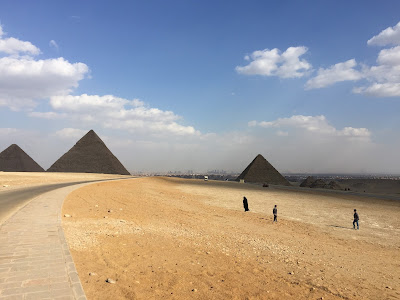Visiting one of the
earliest civilizations and seeing it's technical brilliance, and incredible
feats, while learning of the customs and language used back then is a
tremendous treat. Catching glimpses of all too familiar human nature in their actions - etched into stone - makes it all come to life.
 The areas around modern day Cairo are filled with royal graveyards, typified by the expensive monuments to ego in the life thereafter we refer to as pyramids today. Over a thousand years and almost 30 dynasties, Egyptian Pharaohs ruled what was their modern world. They changed where the capital was, and built up many areas north and south on the Nile from where Cairo is today. As impressive as the nice Giza pyramids are (three larger familiar ones, flanked by two sets of three smaller ones each for Queens), what really tells the story of Egypt is the detail inside.
The areas around modern day Cairo are filled with royal graveyards, typified by the expensive monuments to ego in the life thereafter we refer to as pyramids today. Over a thousand years and almost 30 dynasties, Egyptian Pharaohs ruled what was their modern world. They changed where the capital was, and built up many areas north and south on the Nile from where Cairo is today. As impressive as the nice Giza pyramids are (three larger familiar ones, flanked by two sets of three smaller ones each for Queens), what really tells the story of Egypt is the detail inside.

 To offer some perspective here, we need to understand that economics came into play then, just as it does today. A burial chamber was an expensive proposition, and was constructed in one’s life with clear direction, rather than after death as some sort of testament to one’s greatness. So the costs of regular servicing one’s afterlife had to be financed during one’s life. Decisions around how often post-death nourishment and adornment that should be dropped into a crypt by the priests were weighed carefully. In tomb after tomb the stories on the walls are clearly laid out, and are quite similar. I imagine there was a standard budget and approach of sorts, just as we have burial standards that are largely the same.
To offer some perspective here, we need to understand that economics came into play then, just as it does today. A burial chamber was an expensive proposition, and was constructed in one’s life with clear direction, rather than after death as some sort of testament to one’s greatness. So the costs of regular servicing one’s afterlife had to be financed during one’s life. Decisions around how often post-death nourishment and adornment that should be dropped into a crypt by the priests were weighed carefully. In tomb after tomb the stories on the walls are clearly laid out, and are quite similar. I imagine there was a standard budget and approach of sorts, just as we have burial standards that are largely the same.
In one tomb close to the pyramid of Djoser, a queen’s tomb was adjacent to her son’s nearby to where her husband the King was buried. Her name was Inefrt. Unlike the typical sarcophagus (empty now of course) alone in a room, this chamber featured an alter, and a bench. At first reflection, one might conclude she was a caring person, offering a place to rest. Looking up from the bench however was a clearest set of
instructions (in hieroglyphics of course) you might imagine, of what should be brought, in what quantities, and on what date. The alter was present to ensure the slaughter (lambs) took place within her prevue. So, I might guess this was an early ‘type A’ queen, not leaving anything to chance, and not trusting her servants to get it right. It was this revelation perhaps more than the engineering feats that made the most impression on me. This were just people, royal or not, and as us, they were individuals. To be able to gain a glimpse into the person 4500 years later is remarkable and the thousands of as yet undiscovered burial chambers will doubtless help us understand ourselves even more in the coming years.
-->
 The areas around modern day Cairo are filled with royal graveyards, typified by the expensive monuments to ego in the life thereafter we refer to as pyramids today. Over a thousand years and almost 30 dynasties, Egyptian Pharaohs ruled what was their modern world. They changed where the capital was, and built up many areas north and south on the Nile from where Cairo is today. As impressive as the nice Giza pyramids are (three larger familiar ones, flanked by two sets of three smaller ones each for Queens), what really tells the story of Egypt is the detail inside.
The areas around modern day Cairo are filled with royal graveyards, typified by the expensive monuments to ego in the life thereafter we refer to as pyramids today. Over a thousand years and almost 30 dynasties, Egyptian Pharaohs ruled what was their modern world. They changed where the capital was, and built up many areas north and south on the Nile from where Cairo is today. As impressive as the nice Giza pyramids are (three larger familiar ones, flanked by two sets of three smaller ones each for Queens), what really tells the story of Egypt is the detail inside.
Depending upon the date of the dynasties, certain trends were in place. In the all-too-familiar larger pyramids, the burial chambers have blank walls. Indeed while they may have been packed with papyrus scrolls delineating instructions, these are long gone as the very prominence of the structures made them targets across the ages. It’s the smaller, less impressive structures near Memphis and Saqqaa (also suburban Cairo) that were constructed more cheaply in later Dynasties that have the stories we have come to know. Here the stories are told on the walls of the journey to the after-life, complete with supplies and intentions. While these too were looted down the ages, the stories remained etched in stone for us to piece together a look at the culture and history of this country and it’s individual rulers.

 To offer some perspective here, we need to understand that economics came into play then, just as it does today. A burial chamber was an expensive proposition, and was constructed in one’s life with clear direction, rather than after death as some sort of testament to one’s greatness. So the costs of regular servicing one’s afterlife had to be financed during one’s life. Decisions around how often post-death nourishment and adornment that should be dropped into a crypt by the priests were weighed carefully. In tomb after tomb the stories on the walls are clearly laid out, and are quite similar. I imagine there was a standard budget and approach of sorts, just as we have burial standards that are largely the same.
To offer some perspective here, we need to understand that economics came into play then, just as it does today. A burial chamber was an expensive proposition, and was constructed in one’s life with clear direction, rather than after death as some sort of testament to one’s greatness. So the costs of regular servicing one’s afterlife had to be financed during one’s life. Decisions around how often post-death nourishment and adornment that should be dropped into a crypt by the priests were weighed carefully. In tomb after tomb the stories on the walls are clearly laid out, and are quite similar. I imagine there was a standard budget and approach of sorts, just as we have burial standards that are largely the same. In one tomb close to the pyramid of Djoser, a queen’s tomb was adjacent to her son’s nearby to where her husband the King was buried. Her name was Inefrt. Unlike the typical sarcophagus (empty now of course) alone in a room, this chamber featured an alter, and a bench. At first reflection, one might conclude she was a caring person, offering a place to rest. Looking up from the bench however was a clearest set of
instructions (in hieroglyphics of course) you might imagine, of what should be brought, in what quantities, and on what date. The alter was present to ensure the slaughter (lambs) took place within her prevue. So, I might guess this was an early ‘type A’ queen, not leaving anything to chance, and not trusting her servants to get it right. It was this revelation perhaps more than the engineering feats that made the most impression on me. This were just people, royal or not, and as us, they were individuals. To be able to gain a glimpse into the person 4500 years later is remarkable and the thousands of as yet undiscovered burial chambers will doubtless help us understand ourselves even more in the coming years.




No comments:
Post a Comment